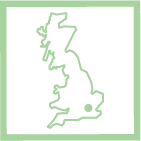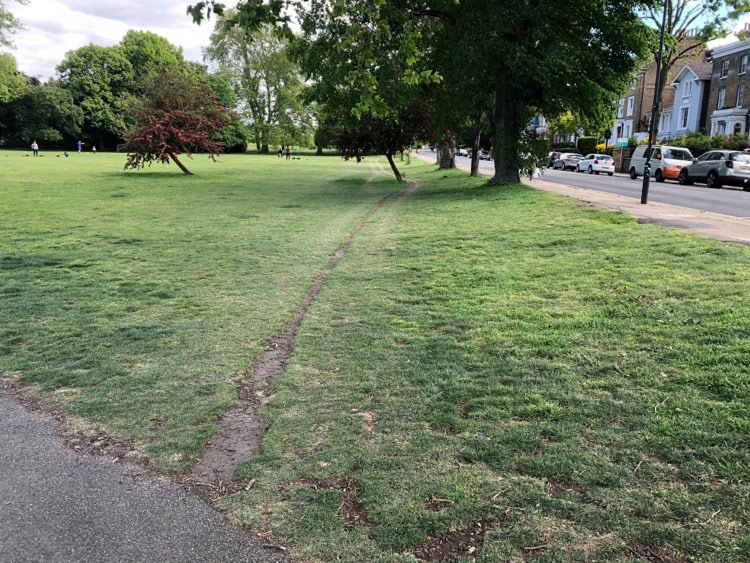
london, uk
When work announced there would be a one day trial of working from home, many in the office began packing up all their possessions, resigned to an inevitability that the trial would swiftly become company-wide policy stretching on for months. Colleagues packed away old notepads for just in case, desk plants for well why not, and half-finished packs of biscuits for better not leave those behind. Each news notification phone ping was met with a tut, a sigh, the headline read out loud, followed by an office commentary rationalising the news with a mix of denial, bargaining, depression or reluctant acceptance.
One week into working from home and the intrinsic kinetic energy of London was cooling down, movement around the capital slowing, the frequency of physical interactions reduced, each trip to the shops seemed a furtive indulgence to buy pasta. FaceTime and Zoom transitioned from a piece of technology your parents were charmingly incapable of using, to an essential way to hear a lagging apology from your boss about the distance between their laptop and router. The medium of quizzing quickly established itself as the only way for five friends to maintain the vague structure of a call and response conversation whilst accommodating for screeching feedback loops, overly sensitive noise gates and dodgy bandwidth.
The last day before being furloughed required me to explain to people I had been working with outside of the company why I couldn’t take calls or emails for the following 7 weeks. Concerned questions on a phone call to America humbled me when I was able to say that my financial situation was secure and, importantly, that I was healthy, and so too was everyone I live with. Another bloody quiz and an ungodly amount of red wine later, in the morning I found myself squeezing a chair onto the cracked patio between my house and the pavement, straining, along with the dandelions, to catch the sun. Children’s drawings of rainbows appeared in windows and flyers advertising street WhatsApp groups were stapled to tree bark. Passers-by greeted each other in ways typically reserved for snow days in rural English villages, or warmer Mediterranean climates. Compensating for seeing fewer people, strangers’ conversations behind scarves extended beyond a nod or a hello.
“Lowly, unpurposeful and random as they may appear, sidewalk contacts are the small change from which a city’s wealth of public life may grow” – Jane Jacobs
My cycles outside were now circular routes, beginning and ending at home, covering an area drastically smaller than the distant memory of a 7 mile commute. Exposure to the hyperlocal area revealed subtle changes in the gardens, parks and verges as spring silently sprung. Paying an increasing amount of attention to the shapes of emerging leaves, the texture of the bark, or the details of flower petals, these gentle illuminations revealed to me how plant blind I had been. I knew the manufacturers name for each car on the street, but had no idea about the species name for each green, woody shade-giver on the same street.
Opening a window into world of plant literacy revealed a map detailing the species and exact location of over 700 000 trees in London, produced as part of a collaboration between 25 London boroughs, the City of London and TFL.
https://maps.london.gov.uk/trees/ Though this map allowed me to put a name to the cherry blossom trees lining my street in New Cross, it covers only a fraction of estimated 8.4m trees in greater London (Human population 8.6m). 21% of London is under canopy cover, according to a report by London i-Tree Eco Project which also financially quantified the ecosystem services of pollution removal, storm water alleviation and carbon sequestration provided by London trees at £133m per year. Two hours spent in nature per week can significantly improve a persons mental and physical health. With the Forestry Commission officially recognising London as a forest, finding myself in a green space considered to be a forest could be done without venturing even as far as Lewisham’s Forest Hill, or Honor Oak.
Food shopping was now confined to one big trip a week, involving a socially distanced queue, a hostile navigation around the aisles of plastic wrapped, aseasonal monocultures, and judgemental looks for the two people nominated to get the week’s worth of food for our house of six. Borne partly out of frustration for our dependence on what was available on the shelves, one quick Google would change the way I thought of both where my food could come from, and the way in which I interact with my city. Cherry blossom recipes.
“Pour half a litre of warm water over half a bag of cherry blossom and leave to infuse in a bowl overnight. Strain the mixture and reduce liquid on a medium heat, before adding 300g of sugar, stirring mixture until dissolved”
I found myself giddily adding sparkling water to sip on a crisp, sweet, floral concoction, grinning at the thought that it had been growing twenty meters from my front door just one day before. Within a week, I had made salt and paprika crisps from the leaves of beech tees growing in Telegraph Hill, pesto from three-cornered leeks growing through pavement cracks in Brockley, and in Peckham Rye found the trees that I would gather elderflowers from when they came into bloom. Through noticing the growth around me, I found myself thinking of London not as a series of buildings with plants conveniently nearby, but as a patchwork of properties only a few centuries old atop a soil that has spent billions of years perfecting the elegant, infinite reciprocity of willing life into plants.
Roads and pavements keep much of London’s soil hidden from view. This leads to a misunderstanding that the bustling community of bacteria, fungal networks and countless other microorganisms is nothing more than a lifeless, inert material we call dirt. Yet as bumps in the pavement allude to roots silently pumping water to the canopy above our head, we are reminded of the unassuming, patient nature of plants; the vibrant, living ecosystem of our soils; and the subterranean indications of life before London.
In the nineteenth century, excavation work for the foundations of Nelsons column encountered the bones of hippopotamus that roamed the land 100 000 years before. In New York, the Mannahatta Project (https://welikia.org/m-map.php ) used soil data to create a map allowing comparison of the city plan today with the native landscape as it was found by Hudson in 1609. The map breaks down each block into information about the plants and wildlife of the area, as well as the trails used by the native Lenape people. The trails, formed at ground level by an instinctive reading of the landscape, were given little regard when urban planners drew up New Yorks grid system. The only road which remains in line with the trails is Broadway, built atop the shortest connecting route between Lenape villages that avoided swamps and hills. Our innate ability to read a landscape can be seen in the subconscious footfall of every park where a path of bare earth cuts between the tarmac paths put in place by urban planners. Desire paths, as they are known, highlight a misalignment between the prescribed routes of built environments and our innate yearning to move in line with natural landscapes . Bicycle couriers in London have noted that the routes they intuitively take follow the paths of subterranean rivers, revealing that an intuitive pull towards Ludgate Circus may have more to do with the River Fleet than the traffic on Fleet Street.
As my furlough period extended into the third (or maybe it was still the second) week, I started losing track of the days. The broken blind in my bedroom meant I was woken early, yet gently, by the sun, rather than abruptly. Alarm. It’s harsh sound still makes me tense up when I hear it on a housemate’s phone. The timeline I previously used as a frame of reference somehow seemed abstract. Amidst the uncertainty of lurching government announcements and reactionary journalism, natures confident, reassuring patterns seemed to be a way to orient myself. We did that barbeque after the cherry blossom had fallen from the tree. We got sunburnt when the blue tits were fledging the nest. We climbed that tree just before the elderflower came into bloom. Time unfolded in concentric circles, in circadian rhythms. The day ended with sunset, and reemerged alongside the dawn chorus.
Venturing out to Hilly Fields in search of nettles, it was becoming apparent that whilst foraged leaves could offer an aspect of any meal, relying on them entirely for sustenance would not fill me up. The hunger it did satisfy had less to do with nutrition and more to do with the liberating lessons provided by nature, and the peace of mind that comes along with it. Chewing on the appetite-supressing, characteristic bitterness of the leaves, I was reminded of the small mercies to be grateful for during this crisis. We were fortunate to go into lockdown during spring, rather than winter. With the city’s parks drawing its citizens into green spaces for their exercise, the bold, flourishing plants in springtime captured the imagination of those who looked out for them. Chalk on pavements began highlighting the names of wildflowers, weeds and trees across Dulwich, Hackney and Walthamstow, equipping the public with the language to overcome their own plant blindness. By raising the profile of these plants, a dialogue to reframe of the role nature plays in a city was started, raising important ecological nuances to our understanding of the capitals public spaces.
Between the moments of disquiet, Corona offers tantalising glimpses of a greener future. Cleaner air, the opportunity to get bored, and the stillness to notice nature re-emerging alongside the buildings. Each generation perceives the ecosystem they live in as normal, and when a degraded ecosystem is passed on to the next generation, a collective generational amnesia allows for a pernicious decline in conditions, known as Shifting Baseline Syndrome. Spring 2020 allowed us to see that a tangible reversal of this phenomenon is possible.
Corona virus has also highlighted the inequalities within our society we must strive to address if we are to build resilience in our public health, and greater balance to life in our city. The pandemic has exacerbated existing social and economic inequalities, disproportionately affecting those most oppressed by our own cultural shifting baseline, increasing transmission rates for all. It must be noted that a common factor of the communities hit hardest by Corona virus is a lack of private outdoor space. Government policy up until recently restricted time spent outdoors in parks and public spaces to one hour, providing we were exercising throughout. Architects and developers understand that incorporating large canopy trees into our urban landscape provides both public health benefits and ecosystem services. We must make sure that these considerations are prioritised in future developments, and such environments are readily accessible to all the citizens of London. Policy frameworks set by the Mayor’s office are in place to protect and maintain London tree cover, with a goal to increase it by 10% set for 2050. ( https://www.london.gov.uk/what-we-do/environment/parks-greenspaces-and-biodiversity/trees-and-woodlands )
Foraging slowed my movement through the city, allowing me to notice plants I would otherwise have rushed past. These places revealed the ways nature lives amongst and despite the city, quietly nurturing optimism in London’s citizens. In the months ahead, our first tentative steps towards reconnecting with loved ones will be made outdoors. As the social distances are bridged, we should remember the grounding and calm reassurance that nature provided for us when we needed it, and the integral social function played by the green spaces in our city.
“To plant a garden is to believe in tomorrow.” – Audrey Hepburn





